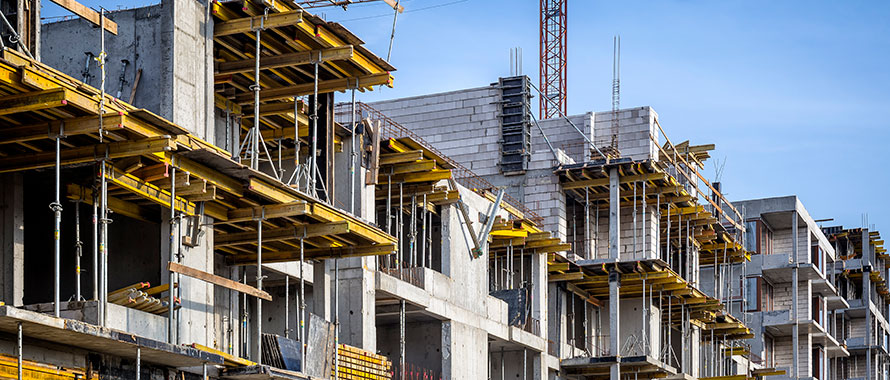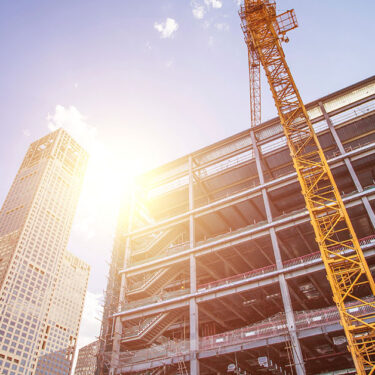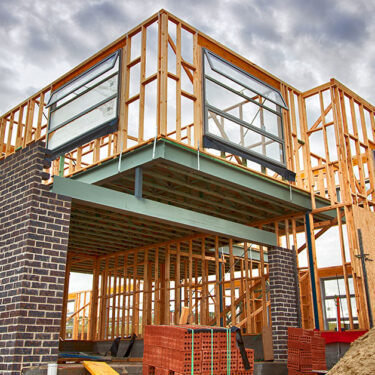A 30-year-old woman was sent to the hospital and listed in critical condition after a concrete slab from an apartment building facade broke off and struck her in the head while she walked down the sidewalk in Philadelphia, Pennsylvania, in early February. Contractors were reportedly working on the building when the concrete slab and debris fell from about two stories up. Witnesses described a horrific scene and said rumbling that “sounded like a bomb” was heard as the concrete crumbled to the ground.
Featured Solutions
“Obviously, this is a tragedy,” said Steven Hrab, Director, Construction, Burns & Wilcox, Toronto, Ontario, but unfortunately, “based on the news reports, there were multiple warnings and fines issued prior to this.”

A 30-year-old getting hit by concrete could sue for many, many millions of dollars. It is likely a hefty claim and that is what CGL Insurance is all about.
A street closure permit for the building had expired Jan. 31, officials said, and exterior building worksites would be required to have warning signage posted. If a lawsuit is filed over the woman’s injuries, the construction company or building owner’s Commercial General Liability (CGL) Insurance could provide coverage, said Kyle Lacertosa, Underwriter, Commercial Insurance, Burns & Wilcox, Parsippany, New Jersey.
“A 30-year-old getting hit by concrete could sue for many, many millions of dollars,” Lacertosa said, pointing to the potential for significant medical expenses, emotional trauma and lost wages. “It is likely a hefty claim and that is what CGL Insurance is all about. The purpose of insurance is to protect your business against the unexpected. This is certainly unexpected.”
‘Everyone involved’ could be named in lawsuit
In a February report from the Center for Construction Research and Training, the number of fatal construction injuries in the U.S. reached 1,102 in 2019, which was the highest level since before 2011. While more construction injuries involve workers, pedestrian incidents do occur. Pedestrian injuries near New York City construction sites were occurring around once a month on average, according to a 2015 Wall Street Journal report that described the incidents as a “little-known threat” in the city, with passerby injuries caused by fallen bricks, windblown fences and other hazards. In Toronto, Ontario, non-worker injuries near construction sites were on the rise as of 2018, CBC News reported at the time.
In urban areas, pedestrian injuries may be more likely to occur due to difficulty closing off streets and walkways, Lacertosa said. While states like New York have stringent regulations on roping off construction sites and installing sidewalk sheds and other protections for the public, fallen debris and other hazards can still cause injuries. “We see it all the time,” he said. “Even if you drop a hammer and it hits somebody, huge settlements are often paid out.”

With any type of exterior work, there should be fencing, netting, and other safeguards to prevent this type of thing from happening.
In April of 2022, a blind man walking with a cane down a sidewalk in Gretna, Louisiana, fell into a construction site hole on the sidewalk that was surrounded by orange fencing, Newsweek reported. City officials planned to follow up with the energy company responsible for the construction about safety concerns at the site. In June of 2022, a pedestrian was struck by a commercial vehicle on a construction site in Calgary, Alberta, CTV News reported.
At any construction site, “there are safety parameters that you have to operate in,” Hrab said. “With any type of exterior work, there should be fencing, netting, and other safeguards to prevent this type of thing from happening,” he said. “Based on photos and videos [from the Philadelphia incident], it looked like no type of safety protocols were in place whatsoever.”
Instead, fencing was reportedly being installed after the accident occurred. “That is the job of a contractor to be very proactive and keep individuals safe on a build site,” Hrab said.
When third-party accidents occur, CGL Insurance could cover the injured individual’s medical expenses, the company’s legal expenses in the event a lawsuit is filed, and settlements or court judgments. Excess Liability Insurance could be needed in cases where settlements exceed standard liability limits. Some construction projects will require excess limits, Lacertosa said.
“Excess Liability Insurance is definitely important, especially when you work on larger projects,” Hrab added. “A standard CGL Insurance limit is $2 million to $5 million. In Canada, a building owner would typically prefer someone be on the site with at least $10 million CGL Insurance limits, so there would have to be some layering or excess limits.”

There is not enough information to say who could be responsible for this, but everyone involved is going to have a potential exposure for this loss.
Depending on the circumstances of the accident, a contractor or design professional’s Architects and Engineers Professional Liability Insurance could also be triggered, particularly if structural work was involved. This type of policy can cover design flaws and losses related to these errors. When serious construction accidents occur, it is common for any companies involved in the project to be pulled into litigation, Hrab said.
“CGL Insurance would be the first responding policy, whether it is the tradesperson’s policy, the general contractor, or the building owner,” Hrab explained. “Everybody is likely to get pulled in. There is not enough information to say who could be responsible for this, but everyone involved is going to have a potential exposure for this loss.”
Lacertosa agreed, noting that the owner’s interest liability coverage on a building proprietor’s CGL Insurance would be important in such a case. “Anybody who stepped on the project site is usually going to get dragged into the lawsuit,” he said.
Enforcing worksite safety
To protect both workers and pedestrians, construction site safety is a critical priority for construction companies and owners of property where construction is taking place. In the U.S., the Occupational Safety and Health Administration conducted more inspections of workplaces in the construction industry last year than any other industry, Construction Dive reported in January. When workers are injured in these accidents, Workers’ Compensation Insurance can provide coverage for an injured employee’s lost wages, medical expenses, and more, while claims alleging a general contractor’s negligence could trigger additional coverage under CGL Insurance, Lacertosa said.
“Many companies do not realize how greatly one bodily injury claim can affect them,” he emphasized. “That can reflect on them for years. Carriers are not going to trust the insured as much, it is going to be tough underwriting, and the rates are going to increase two to three times. It is very important to follow all safety procedures and have a plan in place to avoid this.”
In order to obtain insurance, some carriers will require that construction companies have safety manuals and emergency plans in writing, Lacertosa added.
After a worker died on a construction site in Belleville, Ontario, in January, the province’s Ministry of Labour issued multiple new requirements for the companies involved, Canadian Occupational Safety recently reported. In many construction accidents, including the recent Philadelphia incident, the biggest takeaway is often the need for inspections, according to Hrab. In some cases, insurance carriers will require periodic worksite safety inspections, in which an independent, third-party company conducts an inspection.
“We do not do it often in Canada but sometimes it is necessary,” he said. “If that had been done, it may have prevented that accident from happening.” The cost of such an inspection “is negligible compared to the cost of a potential lawsuit or fatality,” Hrab noted.
If problems are found during an inspection, “this could lead to stop-work orders where nobody is allowed on the job site until it is rectified,” Lacertosa said. “That stops everything, it delays the project, and ultimately the owner could decide to hire a different general contractor.”
Negligence could affect coverage
In the aftermath of the Philadelphia incident, some area residents wondered why a protected walkway was not constructed on the sidewalk to prevent the type of accident that occurred, while a spokesperson for the city said such safeguards are at the discretion of the building owner, WPVI reported on Feb. 8.
“We have to establish the root cause of why this happened,” Hrab said. “It does not seem to be that they were just working on the building, and it happened freakishly, because there is a history of this happening there. Who is not taking these seriously? That is the question. Was there negligence on the site either with those working on the project, the supervisor, or the owners of the building who did not take the appropriate recommendations that someone had given them?”
If a company fails to adhere to government requirements or ignores known safety issues, it is possible that coverage under CGL Insurance or other policies could be affected, Hrab noted. “It can be voided,” he said, though the insurance carrier would likely still pick up some expenses, such as litigation costs. This could be the case, for example, “if someone had advised them about the safety issues and they weighed the cost versus the risk and took the risk.”
“I think they are going to have a trail of individuals saying they brought this to their attention,” Hrab said, adding that this could help alleviate some — but likely not all — potential liability. “It can help their case, but it has to be proven they did their due diligence. There may be a lot of finger-pointing.”
Construction companies that have had regulatory issues or major insurance claims in the past could also have trouble securing new projects in the future, as well as insurance for those projects. “Word travels fast in the industry, and it can result in losing a lot of bids out there that they would have gotten otherwise,” Lacertosa added. “It also greatly affects rating and trust on behalf of the insurance carrier to want to underwrite these accounts, especially if warning signs were there before an incident and they did nothing to rectify it.”

If you do not have a policy and something happens, you are going to have to pay out of pocket for that. That could cripple your business.
In an insurance market that is increasingly narrow for construction companies in certain states, such as New York, working with a knowledgeable broker is key. “It is very important to have a strong retail broker who knows the ins and outs of the construction marketplace,” Lacertosa said, listing work-height exclusions, injury-to-worker exclusions, and other policy provisions that could impact a company’s ability to take on certain projects. “The average contractor is not always going to know what to look for as far as who has good coverage or not.”
Without the right insurance coverage in the event of a loss, companies could be forced to shut down, he said. “It can take years and years for a lawsuit to be resolved or a settlement to be reached. That is why it is so important to have CGL Insurance,” Lacertosa said. “If you do not have a policy and something happens, you are going to have to pay out of pocket for that. That could cripple your business.”







